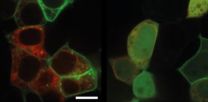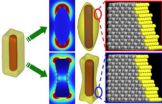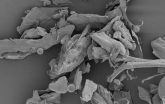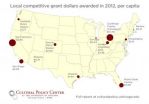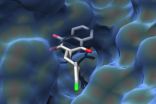(Press-News.org) This news release is available in German.
The Kaposi's sarcoma-associated herpesvirus (KSHV), a gammaherpesvirus that can cause multiple forms of cancer, establishes lifelong infections within the body. To do so the virus has to find a way to modulate the immune system of its host.
„Intruders are usually fought off immediately by an antiviral immune response that is triggered by sensors including the toll-like receptors (TLR)," says HZI researcher Dr. Kendra Bussey, author of the study that was published in the "Journal of Virology". Toll-like receptors detect the virus by binding to structures on the viral surface or the viral DNA, and trigger a signal chain that in the end leads to an antiviral immune response. Ideally this means that the pathogen is eliminated immediately. This mechanism, however, does not seem to work for KSHV and other gammaherpesviruses, as those can remain within the body for a long time.
How the virus does this was unknown until now. The scientists from the HZI research group "Viral Immune Modulation" under the leadership of Prof. Melanie Brinkmann have now been able to show that the virus is actively preventing activation of the innate immune system through Toll-like receptors.
It has yet to be established how exactly and in which part of the Toll-like receptor function is disturbed. This is one of the leverage points for future research: "The better we understand how the virus protects itself from attacks by the immune system, the better we can use this knowledge to fight infections," Brinkmann says.
This may lead to the development of new drugs against gammaherpesviruses. "Those agents could actively protect the immune system and prevent viruses from winning the fight against it," says Bussey. "However, this is still a long way off."
INFORMATION:
Original publication
Kendra A. Bussey, Elisa Reimer, Helene Todt, Brigitte Denker, Antonio Gallo, Andreas Konrad, Matthias Ottinger, Heiko Adler, Michael Stürzl, Wolfram Brune, and Melanie M. Brinkmann
The gammaherpesviruses KSHV and MHV68 modulate the TLR-induced proinflammatory cytokine response
J. Virol. published ahead of print 4 June 2014 , doi:10.1128/JVI.00841-14
The Helmholtz Centre for Infection Research (HZI)
Scientists at the Helmholtz Centre for Infection Research in Braunschweig, Germany, are engaged in the study of different mechanisms of infection and of the body's response to infection. Helping to improve the scientific community's understanding of a given bacterium's or virus' pathogenicity is key to developing effective new treatments and vaccines.
http://www.helmholtz-hzi.de
Ideally, our immune system will recognize and subsequently eliminate pathogens that enter our bodies. However, many microorganisms and viruses have evolved strategies to evade immune detection. The "Viral Immune Modulation" research group seeks to uncover the different mechanisms that particularly herpes viruses use to perform this feat.
Herpesviruses undercover
HZI scientists unravel how herpesviruses fight against our immune system
2014-06-06
ELSE PRESS RELEASES FROM THIS DATE:
Opening a wide window on the nano-world of surface catalysis
2014-06-06
Surface catalysts are notoriously difficult to study mechanistically, but scientists at the University of South Carolina and Rice University have shown how to get real-time reaction information from Ag nanocatalysts that have long frustrated attempts to describe their kinetic behavior in detail.
The key to the team's success was bridging a size gap that had represented a wide chasm to researchers in the past. To be effective as nanocatalysts, noble metals such as Au, Pt, Pd and Ag typically must be nanoparticles smaller than 5 nm, says Hui Wang, an assistant professor ...
Exotic particle confirmed
2014-06-06
This news release is available in French. For decades, physicists have searched in vain for exotic bound states comprising more than three quarks. Experiments performed at Jülich's accelerator COSY have now shown that, in fact, such complex particles do exist in nature. This discovery by the WASA-at-COSY collaboration has been published in the journal Physical Review Letters. The measurements confirm results from 2011, when the more than 120 scientists from eight countries discovered for the first time strong indications for the existence of an exotic dibaryon made ...
Early exposure to certain bacteria may protect toddlers from wheezing
2014-06-06
WHAT: Research funded by the National Institutes of Health (NIH) suggests that exposure to specific combinations of allergens and bacteria within the first year of life may protect children from wheezing and allergic disease. These observations come from the Urban Environment and Childhood Asthma (URECA) study, which aims to identify factors responsible for asthma development in children from inner-city settings, where the disease is more prevalent and severe. Since 2005, the URECA study has enrolled 560 children from four cities—Baltimore, Boston, New York and St. Louis. ...
New report: Local public grants for art varies across US
2014-06-06
Local direct public funding provided through grants for the arts in Chicago is low compared to peer regions in both total dollar and per capita terms, according to a new report from the Cultural Policy Center at the University of Chicago.
The study tracks direct public funding for the arts in 13 regions from 2002-2012. It provides a nuanced look at how much money comes to the nonprofit arts from national, state and local arts agencies, with an emphasis on the important role of local arts agencies. While most studies of public funding for the arts use appropriations made ...
HIV transmission networks mapped to reduce infection rate
2014-06-06
Researchers at the University of California, San Diego School of Medicine have mapped the transmission network of human immunodeficiency virus (HIV) in San Diego. The mapping of HIV infections, which used genetic sequencing, allowed researchers to predictively model the likelihood of new HIV transmissions and identify persons at greatest risk for transmitting the virus.
The findings are published online in the June 5 issue of the journal PLOS ONE.
"The more we understand the structure and dynamics of an HIV transmission network, the better we can identify 'hot spots' ...
Alcohol may protect trauma patients from later complications
2014-06-06
Injured patients who have alcohol in their blood have a reduced risk for developing cardiac and renal complications, according to a study from the University of Illinois at Chicago School of Public Health. Among patients who did develop complications, those with alcohol in their blood were less likely to die.
The study is published in the June issue of the journal Alcohol.
"After an injury, if you are intoxicated there seems to be a substantial protective effect," says UIC injury epidemiologist Lee Friedman, author of the study. "But we don't fully understand why this ...
Is glaucoma a brain disease?
2014-06-06
Rockville, Md. — Findings from a new study published in Translational Vision Science & Technology (TVST) show the brain, not the eye, controls the cellular process that leads to glaucoma. The results may help develop treatments for one of the world's leading causes of irreversible blindness, as well as contribute to the development of future therapies for preserving brain function in other age-related disorders like Alzheimer's.
In the TVST paper, Refined Data Analysis Provides Clinical Evidence for Central Nervous System Control of Chronic Glaucomatous Neurodegeneration, ...
Clinical review published in JAMA
2014-06-06
Many women experience bothersome urine loss with laughing, coughing and sneezing (stress urinary incontinence) AND on their way to the bathroom (urge urinary incontinence). When women experience both types of urine leakage, their condition is called mixed urinary incontinence. It is estimated that 20 to 36 percent of women suffer from mixed urinary incontinence, which is challenging to diagnose and treat because symptoms vary and guidelines for treatment are not clear.
A clinical review entitled "Clinical Crossroads – Female Mixed Urinary Incontinence" by Deborah L. ...
Prostate cancer biomarkers identified in seminal fluid
2014-06-06
Improved diagnosis and management of one of the most common cancers in men – prostate cancer – could result from research at the University of Adelaide, which has discovered that seminal fluid (semen) contains biomarkers for the disease.
Results of a study now published in the journal Endocrine-Related Cancer have shown that the presence of certain molecules in seminal fluid indicates not only whether a man has prostate cancer, but also the severity of the cancer.
Speaking in the lead-up to Men's Health Week (9-15 June), University of Adelaide research fellow and lead ...
Toward a better drug against malaria
2014-06-06
This news release is available in German.
A research team led by Prof. Dr. Carola Hunte of the University of Freiburg/ Germany has succeeded in describing how the antimalarial drug atovaquone binds to its target protein. The scientists used x-ray crystallography to determine the three-dimensional structure of the protein with the active substance bound. The drug combination atovaquone-proguanil (Malarone®) is a medication used worldwide for the prevention and treatment of malaria. The data and the resulting findings concerning the mode of action of atovaquone could ...
LAST 30 PRESS RELEASES:
Scientists use ultrasound to soften and treat cancer tumors without damaging healthy tissue
Community swimming program for Black youth boosts skills, sense of belonging, study finds
Specific depressive symptoms in midlife linked to increased dementia risk
An ‘illuminating’ design sheds light on cholesterol
Who is more likely to get long COVID?
Study showcases resilience and rapid growth of “living rocks”
Naval Research Lab diver earns Office of Naval Research 2025 Sailor of the Year
New Mayo-led study establishes practical definition for rapidly progressive dementia
Fossil fuel industry’s “climate false solutions” reinforce its power and aggravate environmental injustice
Researchers reveal bias in a widely used measure of algorithm performance
Alcohol causes cancer. A study from IOCB Prague confirms damage to DNA and shows how cells defend against it
Hidden viruses in wastewater treatment may shape public health risks, study finds
Unlock the power of nature: how biomass can transform climate mitigation
Biochar reshapes hidden soil microbes that capture carbon dioxide in farmland
Reducing saturated fat intake shows mortality benefit, but only in high-risk individuals
Manta rays create mobile ecosystems, study finds
Study: Mixed results in using lipoic acid to treat progressive multiple sclerosis
Norbert Holtkamp appointed director of Fermi National Accelerator Laboratory
New agentic AI platform accelerates advanced optics design
Biologists discover neurons use physical signals — not electricity — to stabilize communication
Researchers discover that a hormone can access the brain by hitchhiking
University of Oklahoma researcher awarded funding to pursue AI-powered material design
Exploring how the visual system recovers following injury
Support for parents with infants at pediatric check-ups leads to better reading and math skills in elementary school
Kids’ behavioral health is a growing share of family health costs
Day & night: Cancer disrupts the brain’s natural rhythm
COVID-19 vaccination significantly reduces risk to pregnant women and baby
The role of vaccination in maternal and perinatal outcomes associated with COVID-19 in pregnancy
Mayo Clinic smartwatch system helps parents shorten and defuse children's severe tantrums early
Behavioral health spending spikes to 40% of all children’s health expenditures, nearly doubling in a decade
[Press-News.org] Herpesviruses undercoverHZI scientists unravel how herpesviruses fight against our immune system
